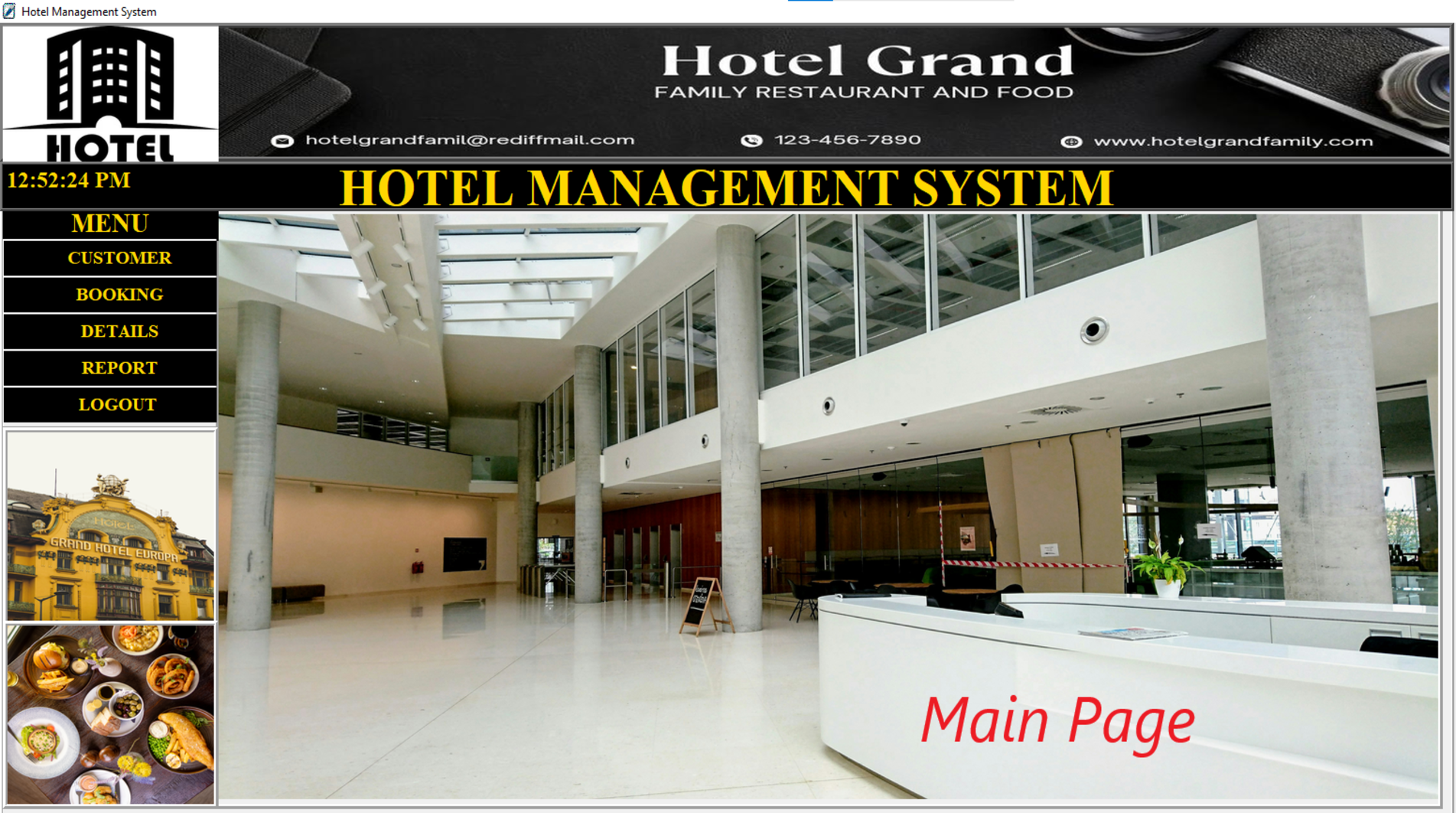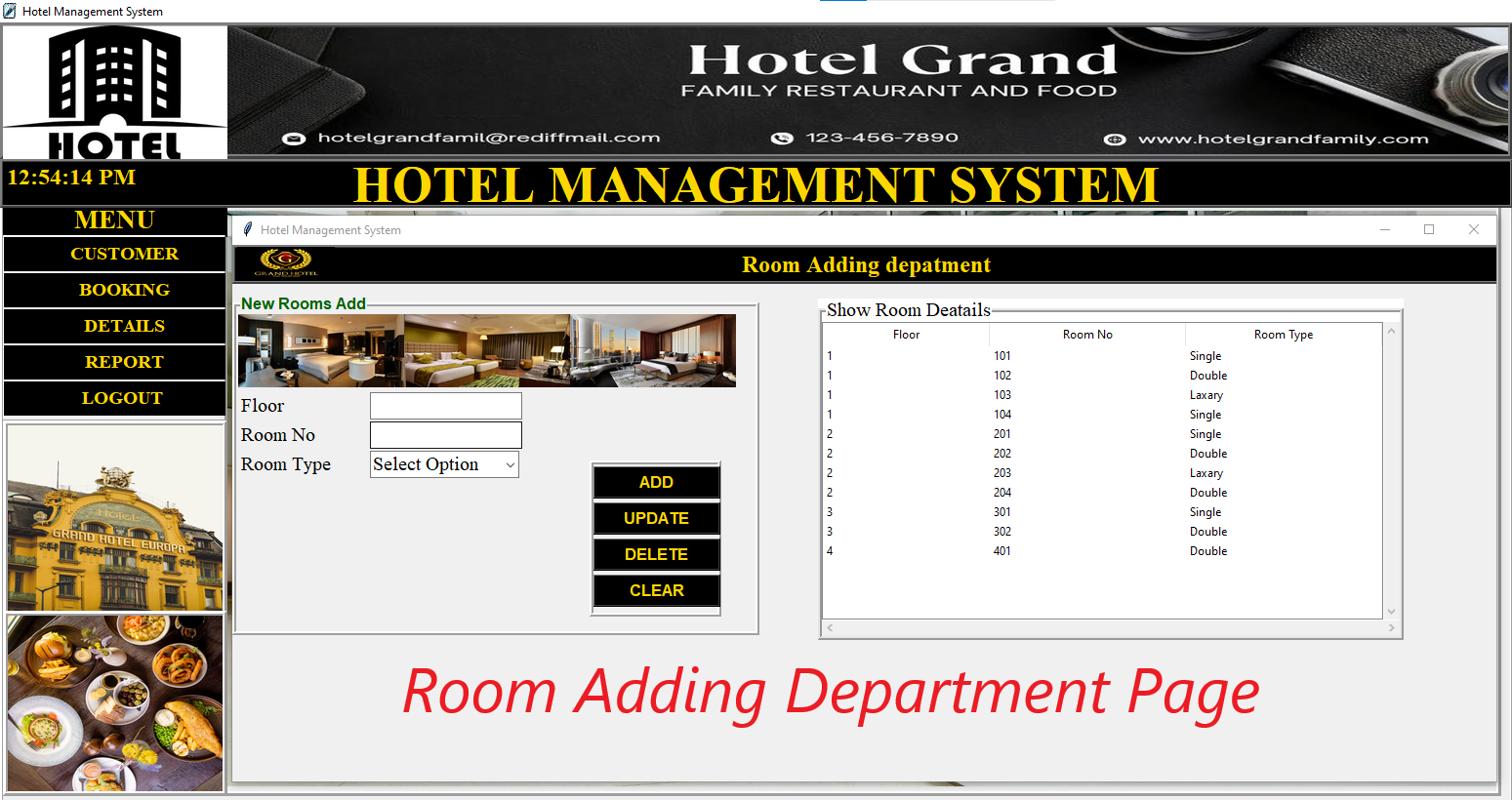Project information
- Category: Python Project
- Project date: 14 June, 2024
- Project URL: none
- Project Name: A Grand Hotel Project - Hotel Management System
- Technologies Use: Python Language
A Grand Hotel Project - Hotel Management System
Overview:
The hotel management system aims to maintain and manage the various hotel tasks and processes. It is primarily responsible for hotel management in the database's core section. The system gives information on the various hotels that are available, as well as their current availability status. Guests can come to the website and register with the system by providing the required information. Each registered guest can request unit reservations. The guests are given information about the availability of the units because they have requested a specific time. This application allows the hotel management the ability to operate the entire system from a single online interface, giving them more power and flexibility. Room booking, staff management, and other hotel management services are included in this project. The manager can use the system to advertise available rooms. Customers may see and reserve rooms from the comfort of their own homes. Admin has the authority to approve or reject a customer's booking request. Other hotel services are also available for consumers to see and book. As a result, the system may be used by both consumers and management to control hotel activities on the go.Introduction:
The entire project has been develped keeping in view of the Distributed client server computing technology in mind. The specification have been normalized upto 3NF to eliminate all the anomalies that may arise due to the database transactions that are executed by the actual administration and users.The user interfaces are browser specific to give distributed accessability for the overall system. The internal database has beeb selected as Oracle 11g.The basic constructs of the tablespaces,clusters and ridexes have been exploited to provide higher consistency and reliability for the data storage. The oracle 11g was a choice as it provides the constructs of high level reliabiity and security. The total front end was dominated using HTML standards applied with the dynamism of JAVA server pages. The communicatin client was designed using servlets. At all proper levels high care was taken to check that the system manages the date consistency with proper business validations. The database connectivity was planned using the Java Database Connectivity, the authorization and authorization was cross checked at all stages. The user level accessabiity has been restricted into two zones the administrative and the normal user zone.Key Features:
Customer Information: This module maintains all the details of the Accommodation location that are available and the units that are available under each location along with their reference unit types.Units Information: This module maintains the information regarding all the units that are registered as per specifications and their reference unit types. The module also takes care of the system from the unit facilities and reference unit facilities that are available.
Booking Module: This module maintains the information of all the booking of the units, as pet the guest requirements, it searches itself with the units station database and the specific registered guest who have raised the demand upon the booking.
Facilities Module:This module maintains the overall activities in the facilities that are available are provided fn all or some of the specified units. This module helps in registering the reference unit facilities that may creep in into the system from time to time.
Technical Details:
Programming Language: The A Grand Hotel Project - Hotel Management System is developed using the Python programming language, known for its efficiency, portability, and versatility.Data Structures:In a hotel management system project implemented in Python with connectivity to MySQL Workbench, data structures and algorithms play a crucial role in various aspects of the system. Here's how they contribute:
Data Storage and Retrieval: Data structures like arrays, linked lists, trees, graphs, and hash tables are used to store and manage various information related to the hotel such as guest details, room availability, reservations, staff information, and billing records. Efficient algorithms are employed for retrieval and manipulation of this data to ensure quick response times and optimal use of system resources.
Search and Sorting: Algorithms for searching and sorting are essential for efficiently locating guest information, room availability, and other relevant data. For example, binary search can be used to quickly find available rooms based on criteria such as room type, price range, and occupancy dates. Sorting algorithms like quicksort or mergesort can be employed to organize data for faster retrieval and presentation.
Optimization: Algorithms are employed to optimize various processes within the hotel management system. For instance, algorithms for optimizing room assignment based on factors like guest preferences, room availability, and pricing can enhance customer satisfaction and maximize hotel revenue. Additionally, algorithms for route optimization can be used in functionalities such as housekeeping scheduling or room service delivery.
Data Integrity and Security: Data structures and algorithms are utilized to ensure data integrity and security within the system. Data structures such as trees and hash tables can be employed to implement efficient data validation and access control mechanisms. Algorithms for encryption and decryption may also be utilized to safeguard sensitive information such as guest personal details and payment data.
Performance Tuning: Efficient data structures and algorithms are crucial for achieving optimal performance of the hotel management system. Performance tuning techniques such as caching, indexing, and query optimization are employed to enhance the speed and responsiveness of database operations, thereby improving overall system performance and user experience.
Usage:
The A Grand Hotel Project - Hotel Management System Project is a pivotal tool for modern hotels, automating and centralizing essential tasks such as reservation management, guest check-in/check-out, room allocation, billing. By integrating these functions into a cohesive software solution, the system enhances operational efficiency, reduces manual errors, and improves guest satisfaction. With features like mobile check-in, and real-time room status updates, the project streamlines processes, enhances communication between staff and guests, and enables proactive management of hotel resources. Additionally, the system facilitates data analysis, providing valuable insights into guest preferences, booking trends, and revenue performance, empowering hoteliers to make informed decisions and optimize business strategies. Overall, a hotel management system project is indispensable for hotels seeking to deliver exceptional service, maximize revenue potential, and stay competitive in today's hospitality industry.Dataflow Diagram:

ER Diagram:








